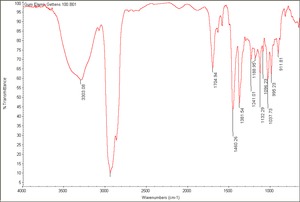Difference between revisions of "Elemi"
| Line 1: | Line 1: | ||
| − | [[File:21-34_Gum Elemi_glass.jpg|thumb|Elemi]] | + | [[File:21-34_Gum Elemi_glass.jpg|thumb|Elemi on glass<br>(visible light left; UV light right)]] |
== Description == | == Description == | ||
A soft, sticky natural resin derived from trees of the family Burseraceae. Because of the high oil content of the elemi resins, the term was used in the 17th and 18th centuries to describe many oleoresin mixtures. Currently the most common is Manila elemi, a malleable resin with a pungent odor obtained from the Pili trees, ''Canarium luzonicum'' and ''Canarium communis'', of the Philippines. Other elemi resins come from Amyris elemifera (Egypt) and Elaphirium elemiferum (Mexico). Elemi has been used as a plasticizer in varnishes, but the components responsible for its initial malleability (mono- and sesquiterpenoids) evaporate and it eventually hardens to a brittle film. Elemi is used in lithographic inks, textile coatings, paper coatings, perfume bases, and waterproofing. | A soft, sticky natural resin derived from trees of the family Burseraceae. Because of the high oil content of the elemi resins, the term was used in the 17th and 18th centuries to describe many oleoresin mixtures. Currently the most common is Manila elemi, a malleable resin with a pungent odor obtained from the Pili trees, ''Canarium luzonicum'' and ''Canarium communis'', of the Philippines. Other elemi resins come from Amyris elemifera (Egypt) and Elaphirium elemiferum (Mexico). Elemi has been used as a plasticizer in varnishes, but the components responsible for its initial malleability (mono- and sesquiterpenoids) evaporate and it eventually hardens to a brittle film. Elemi is used in lithographic inks, textile coatings, paper coatings, perfume bases, and waterproofing. | ||
| − | + | [[[SliderGallery rightalign|Gum Elemi, Gettens 100.B01.TIF~FTIR(MFA)]]] | |
== Synonyms and Related Terms == | == Synonyms and Related Terms == | ||
elemi (Deut., Esp., It., Pol.); elemi gum; Luzon; Manila elemi; Nauli elemi; gum elemi; canarium; elemi resin | elemi (Deut., Esp., It., Pol.); elemi gum; Luzon; Manila elemi; Nauli elemi; gum elemi; canarium; elemi resin | ||
| − | + | ==Physical and Chemical Properties== | |
| − | == | ||
| − | |||
| − | |||
| − | |||
| − | |||
| − | |||
| − | |||
| − | + | * Soluble in ethanol, ether, chloroform, benzene. Insoluble in water, turpentine and mineral spirits. | |
| − | + | * Contains phellandrene, dipentene, elemol, elemicin, terpineol, carvone and terpinolene. | |
| − | + | * Saponification number = 25-50. | |
| − | + | * Acid number = 17.8-25. | |
| − | + | * Melting Point = 177-121 C | |
== Comparisons == | == Comparisons == | ||
| Line 27: | Line 20: | ||
[[media:download_file_104.pdf|Properties of Natural Resins]] | [[media:download_file_104.pdf|Properties of Natural Resins]] | ||
| − | + | ==Resources and Citations== | |
| − | |||
| − | == | ||
* R. J. Gettens, G.L. Stout, ''Painting Materials, A Short Encyclopaedia'', Dover Publications, New York, 1966 | * R. J. Gettens, G.L. Stout, ''Painting Materials, A Short Encyclopaedia'', Dover Publications, New York, 1966 | ||
| Line 39: | Line 30: | ||
* Kurt Wehlte, ''The Materials and Techniques of Painting'', Van Nostrand Reinhold Co., New York, 1975 | * Kurt Wehlte, ''The Materials and Techniques of Painting'', Van Nostrand Reinhold Co., New York, 1975 | ||
| − | * ''Encyclopedia Britannica'', http://www.britannica.com Comment: "Burseraceae." | + | * ''Encyclopedia Britannica'', http://www.britannica.com Comment: "Burseraceae." Accessed 14 Apr. 2004 . |
| − | * | + | * "Violin Varnish Glossary" at www.violins.on.ca/luthier.vargloss.html - gives tree name as Cananarium commune |
| − | * Wikipedia | + | * Wikipedia: http://en.wikipedia.org/wiki/Elemi |
| − | * Art and Architecture Thesaurus Online, | + | * Art and Architecture Thesaurus Online, https://www.getty.edu/research/tools/vocabulary/aat/, J. Paul Getty Trust, Los Angeles, 2000 |
[[Category:Materials database]] | [[Category:Materials database]] | ||
Latest revision as of 15:21, 1 August 2022
Description
A soft, sticky natural resin derived from trees of the family Burseraceae. Because of the high oil content of the elemi resins, the term was used in the 17th and 18th centuries to describe many oleoresin mixtures. Currently the most common is Manila elemi, a malleable resin with a pungent odor obtained from the Pili trees, Canarium luzonicum and Canarium communis, of the Philippines. Other elemi resins come from Amyris elemifera (Egypt) and Elaphirium elemiferum (Mexico). Elemi has been used as a plasticizer in varnishes, but the components responsible for its initial malleability (mono- and sesquiterpenoids) evaporate and it eventually hardens to a brittle film. Elemi is used in lithographic inks, textile coatings, paper coatings, perfume bases, and waterproofing.
Synonyms and Related Terms
elemi (Deut., Esp., It., Pol.); elemi gum; Luzon; Manila elemi; Nauli elemi; gum elemi; canarium; elemi resin
Physical and Chemical Properties
- Soluble in ethanol, ether, chloroform, benzene. Insoluble in water, turpentine and mineral spirits.
- Contains phellandrene, dipentene, elemol, elemicin, terpineol, carvone and terpinolene.
- Saponification number = 25-50.
- Acid number = 17.8-25.
- Melting Point = 177-121 C
Comparisons
Resources and Citations
- R. J. Gettens, G.L. Stout, Painting Materials, A Short Encyclopaedia, Dover Publications, New York, 1966
- G.S.Brady, Materials Handbook, McGraw-Hill Book Co., New York, 1971 Comment: p. 291
- Ralph Mayer, A Dictionary of Art Terms and Techniques, Harper and Row Publishers, New York, 1969 (also 1945 printing)
- Kurt Wehlte, The Materials and Techniques of Painting, Van Nostrand Reinhold Co., New York, 1975
- Encyclopedia Britannica, http://www.britannica.com Comment: "Burseraceae." Accessed 14 Apr. 2004 .
- "Violin Varnish Glossary" at www.violins.on.ca/luthier.vargloss.html - gives tree name as Cananarium commune
- Wikipedia: http://en.wikipedia.org/wiki/Elemi
- Art and Architecture Thesaurus Online, https://www.getty.edu/research/tools/vocabulary/aat/, J. Paul Getty Trust, Los Angeles, 2000

